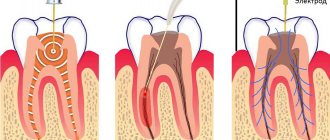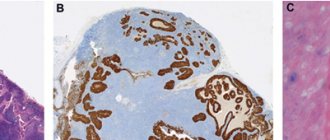Cauterization of the tonsils (ablation) is a modern method of treating chronic tonsillitis, which consists of partial removal (evaporation) of damaged tonsil tissue.
Author:
- Filatova Evgenia Vladimirovna
otolaryngologist, rhinosurgeon
3.64 (Votes: 11)
Cauterization of the tonsils (ablation) is a modern method of treating chronic tonsillitis, which consists of partial removal (evaporation) of damaged tonsil tissue.
Indications for cauterization of tonsils
The surface of the tonsil has depressions - lacunae, they are needed to increase the area of the “working” surface. Allergens and microbial agents, when they enter the mucous membrane, cause an immune response from the body. Chronic inflammation leads to the formation of non-functional scar tissue, the lacunae narrow, and their drainage is impaired. All this leads to the accumulation of caseous plugs in the lacunae. If there are no indications for complete removal of the tonsils, then conservative treatment is carried out: washing the lacunae, physiotherapy. However, soon the lacunae are again “clogged” with plugs and the symptoms of the disease make themselves felt. To improve the functioning of the tonsil, it is recommended to carry out cauterization (ablation). The essence of this procedure is that the superficial layer of the tonsil is bloodlessly removed using a laser or radio wave. After this procedure, purulent plugs do not accumulate in the gaps, their size is reduced, the surface becomes smoother, and inflammation decreases. This way it is possible to achieve stable remission of the disease.
Contraindications to laser intervention
Removal of tonsils with a laser is contraindicated for patients with cancer, diseases of the hematopoietic organs, blood clotting disorders, mental and nervous system disorders, and serious heart, liver and kidney diseases.
Manipulations to remove hypertrophied tonsils should be postponed during periods of exacerbation of acute infectious, viral and rheumatoid diseases, the active stage of tuberculosis, diabetes mellitus, hypertension and during female menstruation. In addition, tonsil removal is not performed on pregnant and lactating women and children under 10 years of age.
Cauterization methods
| Method | What is used | Advantages | Flaws |
| Cryotherapy | A liquid nitrogen. Under the influence of liquid nitrogen, the tissue is greatly cooled. Ice crystals form inside the cells, destroying the cell wall. | Bloodless, painless method. Well tolerated by elderly patients. | To achieve a lasting effect, a course of procedures is required. |
| Laser ablation | CO2 laser, holminium or fiber optic laser. The effect is based on the evaporation of liquid (coagulation) of tissue due to laser heating. | Bloodless, painless method. | Heating of the tissues surrounding the tonsil, the formation of a layer of dead tissue, which disappears within 5-7 days. Within 2-3 days after the procedure, discomfort in the throat, similar to a cold. |
| Radio wave ablation | Alternating high-frequency current (radiosurgery devices Surgitron, Curis). The effect is achieved by heating the tissue and evaporating liquid from it. | Bloodless, painless method, good wound healing, gentle effect on surrounding tissues. The procedure is carried out once, and can be repeated after several years. | The formation of a layer of dead tissue, which disappears within 5-7 days; the next day after the procedure, discomfort in the throat, similar to a cold. |
How is the operation performed?
Three hours before the start of the operation, the patient is not recommended to drink or eat. The patient is placed in a surgical chair, and his pharynx is treated with anesthesia. After the anesthesia takes effect, the doctor directs a special device that uses a laser beam to target the tonsils. To avoid burns and damage to healthy tissue, radiation treatment is carried out in 4-5 approaches, each laser session lasts approximately 10-15 seconds. To prevent bleeding, laser coagulation (sealing) of blood vessels is performed. Tonsil removal is performed when the patient pauses breathing after taking a deep breath. To completely remove purulent deposits, large depressions are artificially expanded, then they are smoothed out, and the scars are excised with a laser. Such manipulations make it possible to create a discharge of the contents of the lacunae of the tonsils. When performing tonsillectomy, purulent deposits of the tonsils are completely eliminated. In some cases, within one to two hours after surgery, to eliminate the risk of complications, the patient is monitored and then sent home. Since laser tonsil removal is the most gentle method of treatment, the doctor can perform this manipulation in several stages.
Anesthesia
Tonsillectomy surgery is performed under both local anesthesia and general anesthesia (anesthesia). Both methods of pain relief have pros and cons, so the decision is made by the attending doctor, taking into account the health condition and wishes of the patient.
Local anesthesia
The classic surgical technique (under local anesthesia) has been performed for many decades and still exists today. An anesthetic solution in an amount of about 20 ml is injected into several points around the tonsil - usually 1% lidocaine with the addition of adrenaline (to reduce bleeding). The effect is that the tissues are deeply impregnated with the drug, so the pain is almost not felt, and the tonsil appears to be raised above the palatine arches and is easy to isolate. This technique is called infiltration anesthesia.
If the patient has had allergic reactions to these drugs, they are replaced with ultracaine. Next, the operating doctor proceeds directly to removing the tonsils. The patient is only required to strictly follow his instructions. A tonsillectomy lasts about half an hour; before sending the patient into the room, the surgeon carefully checks whether the bleeding has stopped. This is an important point in the operation.
General anesthesia (anesthesia)
Nowadays, tonsillectomy is performed more and more often under general anesthesia. This is due to the fact that anesthetic equipment and drugs for anesthesia have changed a lot recently. Modern anesthetics are considered to be of a high safety class; they are non-toxic and do not carry the same complications as before. Anesthesia is easily tolerated by the patient and feels similar to normal sleep.
The photo shows an anesthesia device from the German company Drager used in the clinic.
To carry out general anesthesia, the patient is carefully examined; before the operation, he is examined by an anesthesiologist, since, despite the safety of anesthesia, if there are deviations in the tests, the operation can be postponed. The operation is performed strictly on an empty stomach; the patient cannot even drink water. After the examination, the patient is escorted to the operating room, where he is placed on the operating table and put on a breathing mask. A mixture of oxygen and anesthesia medication is supplied to it, sleep occurs within a few minutes, and the operation ends for the patient - awakening occurs in the ward.
Doctors anesthesiologists
The clinic employs highly qualified anesthesiologists, including specialists from the Children's Clinical Hospital named after. N.F. Filatov, who have academic degrees of candidates and doctors of medical sciences, many years of unique work experience. Our specialists use an anesthetic apparatus from the German company Drager and the latest generation of medicines. All this allows operations to be performed under general anesthesia (anesthesia), which is safe for the patient’s health, with further rapid recovery in the postoperative period.
Drugs
In their work, anesthesiologists use the drugs sevoran, diprivan, esmeron, enfluron, isoflurane, dormicum and others. The choice of a specific drug is at the discretion of the anesthesiologist and depends on each specific case, test results and other factors.
Preoperative preparation
Directly for the operation, it is necessary to undergo a preoperative examination, the scope of which is determined by the doctor after the examination.
Preoperative preparation is standard:
- Laboratory tests - general blood test, blood biochemistry, blood for RW, HIV, hepatitis B and C, coagulogram, Rh factor, blood group.
- Instrumental data - ECG, fluorography or chest x-ray.
- Conclusion of specialists - therapist (pediatrician) and dentist about the absence of contraindications to surgical intervention.
Manifestations of tonsil cysts
Symptoms of having a palatal cyst depend on its size and location. Cysts up to 1 cm in size usually do not manifest themselves, are invisible and painless. People, as a rule, do not even suspect their existence. Cysts can be discovered accidentally during routine examinations by an otolaryngologist.
You can suspect the presence of a cyst in the tonsil if you have bad breath with healthy teeth and normally functioning digestive organs. The smell comes from food particles that become trapped in the area of the cyst and begin to decompose there. As the size of the cyst increases, a person may experience the following symptoms:
- feeling of constant presence of a foreign body in the throat;
- sore throat or discomfort;
- difficulty and mild pain when swallowing solid food;
- hoarseness of voice.
Young children may begin to choke on food. If the cyst grows towards the pharynx, then a feeling of lack of air may occur, which is especially pronounced in children whose larynx is small. The existence of the cyst itself maintains chronic inflammation. The cyst excludes areas of the tonsil from immune protection.
DIAGNOSIS OF CHRONIC TONSILLITIS
For frequently recurrent tonsillitis, consultation with an ENT specialist is necessary. The sooner you make an appointment with a doctor, the faster the specialist will provide qualified assistance. The doctor makes a diagnosis based on medical history, examination and research results. The main method for diagnosing chronic tonsillitis is pharyngoscopy. During the examination, the otolaryngologist identifies characteristic signs of the disease: swelling of the mucous membrane, fusion of the palatine arches with the tonsils, formation of adhesions, loose tissue, accumulation of pus in the lacunae, enlarged lymph nodes.
The toxic-allergic form of chronic tonsillitis is the most severe. Relapses occur several times a year and may be accompanied by infectious and inflammatory processes in internal organs and adjacent tissues, and the formation of abscesses. The patient experiences severe weakness, the body temperature may rise, and a sore throat causes severe anxiety and reduces the quality of life. The simple form of chronic tonsillitis occurs with more sparse symptoms: the patient is bothered by a sore throat, which intensifies when swallowing and chewing, weakness and decreased performance.
A common mistake made by patients with chronic tonsillitis is uncontrolled use of medications, including antibiotics. With antibacterial drugs you only slow down the spread of infection, but over time, pathogenic microorganisms adapt to the action of even the most powerful drugs, which lose their therapeutic effect. While the infectious focus of the tonsils is in the oropharynx, antibiotics will only provide temporary relief, but will not solve the problem.
Laser tonsil removal
In medicine, carbon dioxide or diode lasers are used. The cells of the body contain from 60 to 90% fluid. When a laser is applied to an area of tissue, its temperature rises and the liquid begins to evaporate and the protein molecules dry out.
Since the laser energy is mainly distributed at a depth of 2-3 mm, the result is a sequential stratification effect with simultaneous cauterization (coagulation) of small blood vessels. Therefore, the laser cut is almost bloodless. This effect is important - blood loss during surgery is significantly reduced, and the surgeon, working on a dry surface, has a larger field of view.
Advantages of the laser tonsil removal method
When removing tonsils, the destructive and coagulating effects of a laser beam are involved. The first allows the tissue to be removed, the second clots the blood at the incision site and seals the vessels, which prevents bleeding and infection of the wound.
Recovery period
The quality of the operation depends on the professionalism of the doctor. The laser is a sterile instrument that resists septic inflammation of tissues. Regeneration of the pharyngeal mucosa is restored within two to three weeks, in the absence of burns and extensive wounds. Typically, on the 7th day after laser tonsil removal, a postoperative examination is scheduled with the attending physician. To speed up healing, the patient is prescribed rinsing with a special composition. After tonsil removal, treatment with antibacterial drugs is usually not required. During the first 24 hours after laser treatment, the patient is allowed to drink only cool water. It is recommended to turn to a gentle diet of cool, smooth, soft dishes. It is not advisable to eat hard, spicy, fatty or hot foods. Smoking and drinking alcohol is strictly prohibited. After surgery, the patient should not freeze or be physically overloaded. It is advisable to undergo a course of immunity-strengthening treatment.
TREATMENT OF CHRONIC TONSILLITIS: WHY OPERATION?
Medical tactics for chronic tonsillitis are selected based on numerous diagnostic data and examinations. Specialists weigh the pros and cons, assess the risks of complications and make professional forecasts for the future.
In most cases, tonsillectomy is performed when a toxic-allergic form of chronic tonsillitis develops, which, unlike the simple form of the disease, occurs with severe symptoms of intoxication, immunosuppression and a high risk of developing infectious complications.
Radical removal of tonsils for chronic tonsillitis is absolutely justified: if conservative treatment of tonsillitis is ineffective, only surgery can get rid of the source of chronic infection in the pharynx and prevent the spread of infection.
Experts identify more than 100 concomitant diseases that occur with long-term tonsillitis: psoriasis, nephritis, eczema, prostatitis, scleroderma, lupus erythematosus, rheumatism and other pathologies. You should not postpone the operation if the specialist insists on it. The tonsils lose their main protective functions and turn into a dangerous source of infection.
There are certain indications for surgical treatment of chronic tonsillitis, on the basis of which the doctor makes a decision on the need for surgery.







